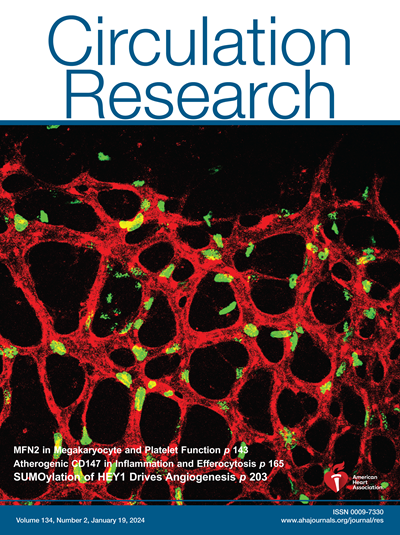Macrophage DNases Limit Neutrophil Extracellular Trap-Mediated Defective Efferocytosis in Atherosclerosis.
IF 16.2
1区 医学
Q1 CARDIAC & CARDIOVASCULAR SYSTEMS
引用次数: 0
Abstract
BACKGROUND Neutrophil extracellular traps (NETs) contribute to atherosclerosis progression and are linked to adverse clinical outcomes such as myocardial infarction and stroke. Although the triggers of NET formation in plaques are known, the mechanisms governing DNase-mediated NET clearance and how these are disrupted during atherosclerosis remain unclear. Moreover, the consequences of impaired NET clearance on disease progression are not known. METHODS Low-density lipoprotein receptor knockout (Ldlr-/-) mice with hematopoietic cell-specific deletion of DNase1 and DNase1L3 were fed a Western-type diet for 16 weeks to examine the impact of loss of DNase activity and the subsequent NET accumulation on advanced atherosclerosis. The effect of NETs on macrophage efferocytosis was examined in vitro and in the mouse peritoneal cavity and atherosclerotic plaque in vivo. To identify the signaling pathway impairing the NET-induced DNase response, in vitro assays were performed using selective endoplasmic reticulum stress pathway inhibitors, and the findings were validated in murine and human atherosclerotic tissues. RESULTS Lack of DNase secretion by macrophages led to accumulation of NETs in local tissues, including atherosclerotic plaques. Persisting NETs in turn promoted cleavage of the efferocytosis receptor MerTK, resulting in defective macrophage efferocytosis and increased atherosclerotic plaque necrosis. In vitro screening identified endoplasmic reticulum stress-induced activation of the PERK (protein kinase R-like endoplasmic reticulum kinase)-ATF (activating transcription factor) 4 signaling axis in atherogenic macrophages as a key driver of impaired DNase secretion, leading to delayed NET clearance and their pathological persistence. Treatment of human atherosclerotic plaques and Ldlr-/- mice with integrated stress response inhibitor, a selective PERK inhibitor, restored vascular DNase secretion and facilitated NET clearance. CONCLUSIONS Macrophages play a key role in clearing NETs from tissues. Endoplasmic reticulum stress suppresses macrophage DNase secretion, leading to NET accumulation in atherosclerotic plaques, which triggers efferocytosis impairment and plaque progression. Targeting the PERK-ATF4 axis to restore DNase release and NET clearance represents a promising therapeutic strategy to promote plaque stabilization.巨噬细胞dna酶限制动脉粥样硬化中中性粒细胞胞外陷阱介导的有缺陷的Efferocytosis。
中性粒细胞胞外陷阱(NETs)有助于动脉粥样硬化的进展,并与不良的临床结果(如心肌梗死和中风)有关。虽然已知斑块中NET形成的触发因素,但控制dna介导的NET清除的机制以及这些在动脉粥样硬化期间如何被破坏仍不清楚。此外,NET清除受损对疾病进展的影响尚不清楚。方法用慢密度脂蛋白受体敲除(Ldlr-/-)、造血细胞特异性缺失DNase1和DNase1L3的小鼠饲喂西式饮食16周,观察DNase活性丧失和随后的NET积累对晚期动脉粥样硬化的影响。在体外、小鼠腹腔和动脉粥样硬化斑块中观察了NETs对巨噬细胞efferocytic的影响。为了确定损害net诱导的DNase反应的信号通路,使用选择性内质网应激途径抑制剂进行了体外实验,并在小鼠和人类动脉粥样硬化组织中验证了这一发现。结果巨噬细胞DNase分泌的减少导致局部组织(包括动脉粥样硬化斑块)内NETs的积累。持续的NETs反过来促进了efferocytosis受体MerTK的裂解,导致巨噬细胞efferocytosis缺陷和动脉粥样硬化斑块坏死增加。体外筛选发现,粥样硬化性巨噬细胞内质网应激诱导的PERK(蛋白激酶r样内质网激酶)-ATF(激活转录因子)4信号轴的激活是DNase分泌受损的关键驱动因素,导致NET清除延迟及其病理持久性。综合应激反应抑制剂(一种选择性PERK抑制剂)治疗人类动脉粥样硬化斑块和Ldlr-/-小鼠,恢复血管DNase分泌,促进NET清除。结论巨噬细胞在清除组织内NETs中起关键作用。内质网应激抑制巨噬细胞DNase分泌,导致动脉粥样硬化斑块内NET积聚,从而引发efferocytic损伤和斑块进展。靶向PERK-ATF4轴恢复DNase释放和NET清除是一种有前景的促进斑块稳定的治疗策略。
本文章由计算机程序翻译,如有差异,请以英文原文为准。
求助全文
约1分钟内获得全文
求助全文
来源期刊

Circulation research
医学-外周血管病
CiteScore
29.60
自引率
2.00%
发文量
535
审稿时长
3-6 weeks
期刊介绍:
Circulation Research is a peer-reviewed journal that serves as a forum for the highest quality research in basic cardiovascular biology. The journal publishes studies that utilize state-of-the-art approaches to investigate mechanisms of human disease, as well as translational and clinical research that provide fundamental insights into the basis of disease and the mechanism of therapies.
Circulation Research has a broad audience that includes clinical and academic cardiologists, basic cardiovascular scientists, physiologists, cellular and molecular biologists, and cardiovascular pharmacologists. The journal aims to advance the understanding of cardiovascular biology and disease by disseminating cutting-edge research to these diverse communities.
In terms of indexing, Circulation Research is included in several prominent scientific databases, including BIOSIS, CAB Abstracts, Chemical Abstracts, Current Contents, EMBASE, and MEDLINE. This ensures that the journal's articles are easily discoverable and accessible to researchers in the field.
Overall, Circulation Research is a reputable publication that attracts high-quality research and provides a platform for the dissemination of important findings in basic cardiovascular biology and its translational and clinical applications.
 求助内容:
求助内容: 应助结果提醒方式:
应助结果提醒方式:


